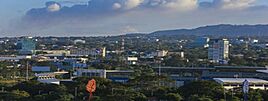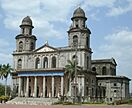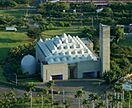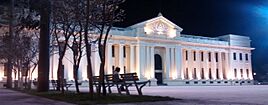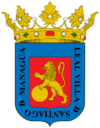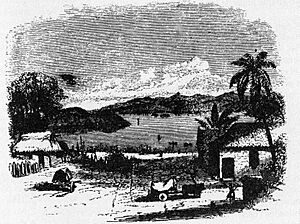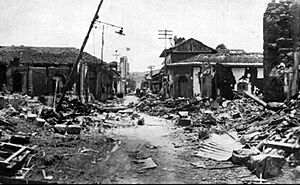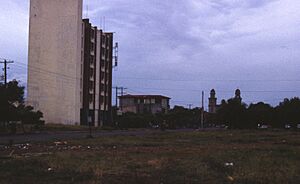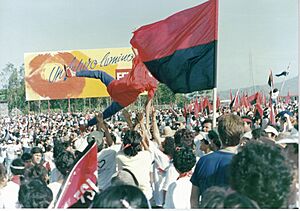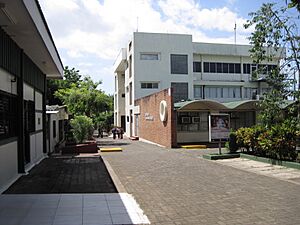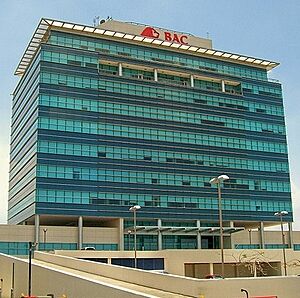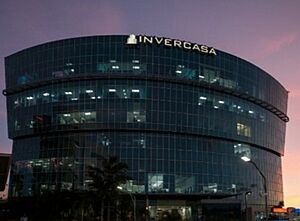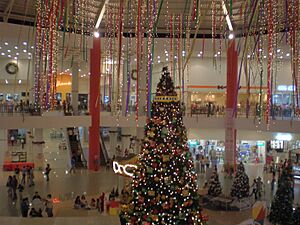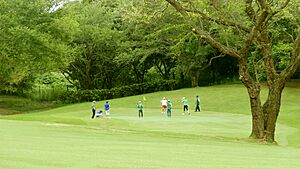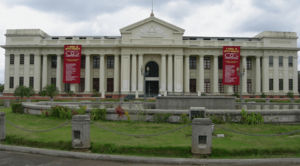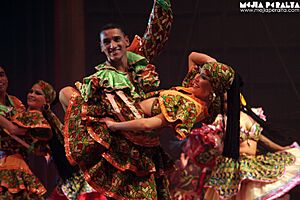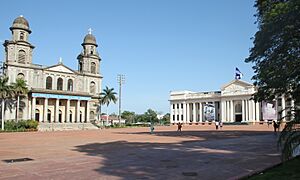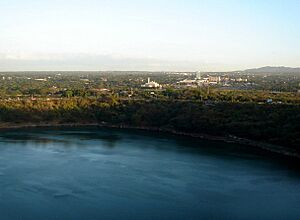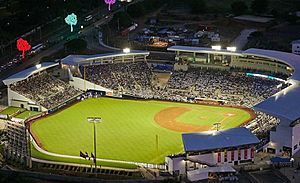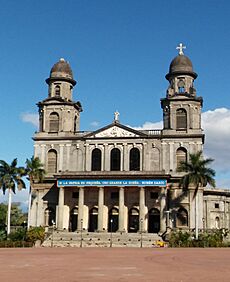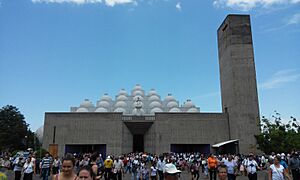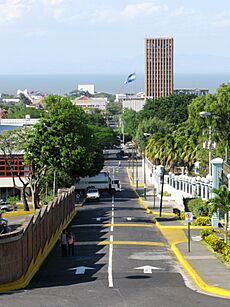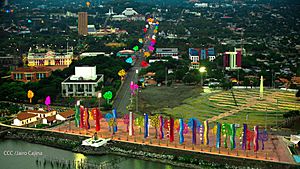Managua facts for kids
Quick facts for kids
Managua
Leal Villa de Santiago de Managua
|
|||
|---|---|---|---|
|
|
|||
|
|||
| Nickname(s):
Novia del Xolotlán
(English: The Bride of Xolotlán) |
|||
| Country | |||
| Department | Managua | ||
| Municipality | Managua | ||
| Founded | 1819 | ||
| Elevated to Capital | 1852 | ||
| Area | |||
| • Capital city | 267 km2 (103 sq mi) | ||
| Elevation | 82.97 m (272.21 ft) | ||
| Population
(2022 estimate)
|
|||
| • Capital city | 1,061,054 | ||
| • Density | 3,974/km2 (10,293/sq mi) | ||
| • Urban | 1,051,236 | ||
| • Metro | 1,401,687 | ||
| Demonyms | managua, managüense, capitalino/a | ||
| GDP (PPP, constant 2015 values) | |||
| • Year | 2023 | ||
| • Total | $9.4 billion | ||
| • Per capita | $8,600 | ||
| Time zone | UTC−6 | ||
| ISO 3166 code | NI-MN | ||
| Website | http://www.managua.gob.ni/ | ||
Managua is the capital and largest city of Nicaragua. It is also one of the biggest cities in Central America. The city sits on the shores of Lake Managua. In 2020, about 1,055,247 people lived there. Its larger metropolitan area had about 1,401,687 residents. Managua is also the main city of the Managua Department.
Managua was founded in 1819. It became the country's capital in 1852. The city grew very quickly between 1842 and 1930. It became one of the most developed cities in Central America. Earthquakes have damaged the city many times, especially in 1931 and 1972. But the city has always been rebuilt. Today, Managua is a key economic center for Nicaragua and Central America.
Contents
What's in a Name?
The name "Managua" might have two different origins. One idea is that it comes from the Nahuatl language. In Nahuatl, Mana-ahuac means "next to the water" or "surrounded by water." Another idea is that it comes from the Mangue language. In Mangue, managua might have meant "place of the big man" or "chief." People who live in Managua are called managuas, managüenses, or capitalinos.
Managua's Story
Early Beginnings
People lived in Nicaragua as early as 12,000 BC. The ancient footprints of Acahualinca are 2,100-year-old fossils. They were found near Lake Managua. Other old findings include pottery and stone statues. These were found on islands like Zapatera and Ometepe. They help us learn about Nicaragua's ancient past.
Becoming a Capital City
Managua started as a fishing town before Europeans arrived. It became an official town in 1819. Its name was Leal Villa de Santiago de Managua. After Central American countries became free from Spain in 1824, people wanted Managua to be the capital. Nicaragua became an independent country in 1838. Managua was chosen as the capital in 1852. This was because it was located between the rival cities of León and Granada.
Between 1852 and 1930, Managua grew a lot. It became a center for government and services. The city faced big floods in 1876 and 1885. A terrible earthquake in 1931 and a large fire in 1936 destroyed much of it. Under the rule of Anastasio Somoza García (1936–1979), the city was rebuilt and grew quickly. New government buildings, industries, and universities were built. Managua became Central America's most developed city. People today call the Managua from before the 1970s La Antigua Ciudad, which means "The Old City."
Challenges and Rebuilding
Managua's progress stopped suddenly after a second major earthquake on December 23, 1972. This earthquake destroyed 90% of the city center. More than 19,120 people died. Most buildings were badly damaged. It was very hard to rebuild quickly. Emergency workers had to clear away the ruins. Many people who survived moved to the edges of the city.
The Nicaraguan Revolution in 1979 and the Contra War in the 1980s further damaged the city and its economy. Natural disasters, like Hurricane Mitch in 1998, also made recovery harder. After 1990, the city began to rebuild seriously. Many Nicaraguans returned from other countries. Businesses grew, new homes and schools were built. The airport was improved, streets were widened, and old malls were fixed.
Managua Today
In 2006, new programs for education and health were started. Many new government buildings, museums, and public spaces have been built. These have brought back some of the life to downtown Managua. However, most businesses are now on the outskirts of the city. A new sewer system and water treatment plant opened in 2009. This helped clean up Lake Managua and protect wildlife.
Where is Managua?
Managua is located on the southern shores of Lake Managua, also called Lake Xolotlán. This lake has the same types of fish as the larger Lake Cocibolca. For a long time, the lake was polluted. But a new sewer system and a large water treatment plant opened in 2009. This project, funded by the German government, helps clean the lake.
Managua's city area covers about 544 square kilometers (210 square miles). It stretches south from Lake Managua. The lakeshore is about 55 meters (180 feet) above sea level. The city rises as it goes south towards the Sierras de Managua, where it is over 700 meters (2,300 feet) above sea level.
The city is built on fault lines. This means that earthquakes are common. Managua has four smaller crater lakes, called lagoons, within its city limits. The most famous is the Tiscapa Lagoon, which is part of a natural reserve.
Plants and Trees

Managua has a wide variety of plants and trees. This is because of its tropical climate, different types of land, rich soil, and plenty of rain. Many unique trees grow here, like chilamates, ceibos, and madroños. The madroño is Nicaragua's national tree. During the rainy season (May to November), Managua becomes very green. Many palm trees, bushes, and other plants make the city look lush.
Weather in Managua
Managua has a tropical climate. This means it has steady temperatures, usually between 28 and 32 degrees Celsius (82 and 90 degrees Fahrenheit). The city is sunny and hot for most of the year. Temperatures range from about 22 degrees Celsius (72 degrees Fahrenheit) at night to 30 degrees Celsius (86 degrees Fahrenheit) during the day. The hottest months are March, April, and May.
Managua has two main seasons: the dry season and the rainy season. The rainy season is from mid-May to mid-November. The dry season is from mid-November to mid-May. During the dry season, the land outside the city can become dry and dusty.
Learning in Managua
Managua is the main center for education in Nicaragua. Most of the country's best universities and colleges are located here. In 2007, Managua was declared the first capital city in Central America to have almost no illiteracy. This happened after a successful program to teach people to read and write.
Nicaragua has 48 universities and 113 colleges. These schools teach subjects like electronics, computer science, and construction. The education system also includes English language universities and bilingual programs. In 2005, about 400,000 Nicaraguans had a university degree.
Universities in Managua
The National Autonomous University of Nicaragua (UNAN) is the main public university. It was founded in 1812 in León, but its main campus is in Managua. The Polytechnic University of Nicaragua (UPOLI) was founded in 1967.
The INCAE Business School is a private business school. It started in 1964 with help from the United States. It has been ranked as one of the top business schools in Latin America.
Other universities in Managua include:
- American University (UAM)
- Central American University (UCA)
- University of Commercial Sciences (UCC)
- National Agrarian University (UNA)
- National University of Engineering (UNI)
- Catholic University Redemptoris Mater (UNICA)
Managua's Economy
Managua is the economic heart of Nicaragua. It is home to many large national and international businesses. Many factories here make different products. Big companies like Wal-Mart and Telefonica have offices in Managua. The city's main products include beer, coffee, medicines, and shoes. The main goods traded are beef, coffee, and cotton.
Managua is also Nicaragua's main center for politics, culture, and education. The Augusto C. Sandino International Airport is the country's main airport. It connects Managua to the rest of the world.
All the major banks in Nicaragua are in Managua. Many new hotels have also opened, like Crowne Plaza and InterContinental. Managua also has four modern shopping malls: Plaza Inter, Centro Comercial Metrocentro, Galerias Santo Domingo, and Multicentro Las Americas.
There are also large local markets like Mercado Roberto Huembes and Mercado Oriental. Here, you can find everything from food and clothes to electronics and building materials. These markets are popular with both locals and tourists looking for souvenirs.
Culture and Fun

Managua is Nicaragua's cultural capital. It has many restaurants, theaters, museums, and shopping centers. Many people from other countries live here, including those from Taiwan, China, Germany, and the United States.
Managua hosts the annual Miss Nicaragua pageant. This national beauty contest has been held since 1955 at the Rubén Darío National Theatre.
Festivals and Celebrations
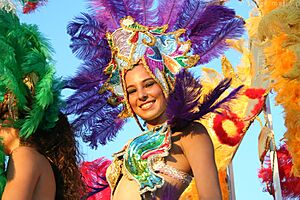
Managua's most famous festival celebrates its patron saint, Santo Domingo de Guzmán. It starts on August 1st. Many people joyfully carry an old statue of Santo Domingo from one church to another across the city. The statue stays there for ten days. On August 10th, it is carried back to its original church. Thousands of people join this event. They dance, eat, drink, and listen to music. Many people dress in traditional costumes and masks.
Another festival is the Alegria por la Vida (Happiness for Life) Carnaval. It is celebrated in Managua in early March. Each year has a different theme. This event includes parades, floats, live music, food, and dancing.
Museums and Art
The National Library in Managua has many books about Nicaragua's history. The National Palace of Culture shows Nicaraguan art from before its independence. Inside the National Palace, the National Museum displays ancient pottery and statues. It also has halls for national history and symbols. The National Palace was one of the few buildings that survived the 1972 earthquake.
Managua has many art galleries. They show works by both Nicaraguan and international artists. There are also different types of museums. These include art museums, natural history museums, and history museums.
The Doctor Roberto Incer Barquero Library helps promote Nicaraguan culture. It has 67,000 books, free internet, and a newspaper archive. It also has a gallery with paintings and a display of Nicaraguan coins and money.
Cultural centers in Managua include the Nicaraguan-North American Culture Center and the French Alliance of Managua.
Fun Things to Do
Managua has many bars, nightclubs, casinos, theaters, and cinemas. Going out for fun is usually not very expensive compared to Western countries. Cinemas in shopping centers show both English and Spanish movies.
Many casinos and karaoke bars have opened since the late 1990s. They are popular with locals and visitors. Popular music includes Palo de Mayo, Merengue, and Cumbia. Salsa dancing is a favorite pastime. Managua has a lively nightlife. Nightclubs and bars are found in popular areas like "Zona Viva" and "Zona Hippos."
Sports in Managua
Baseball is the most popular sport in Nicaragua. Soccer and boxing are also very popular. The Dennis Martínez National Stadium is home to Managua's baseball team, the Boer. When it was built in the 1960s, it was the most modern stadium in Central America.
There is growing interest in amateur soccer. New private courts help promote games and tournaments. Managua also has two golf courses. The city is home to the basketball team Costa Caribe. It also has the Polideportivo Alexis Argüello, an indoor arena for sports events.
Famous Places to See
National Palace of Culture
The National Palace is one of Managua's oldest buildings. It was not damaged by the 1972 earthquake. It was built in 1935. For over 50 years, it was where the country's Congress met. Today, it holds the National Archive and the National Library. It also has the National Museum, which is open to everyone. The museum shows ancient paintings, statues, and pottery.
Rubén Darío National Theatre
The Rubén Darío National Theatre is Nicaragua's most important theater. It is one of the most modern theaters in Central America. Artists from Nicaragua and other countries perform here. They put on shows, concerts, and cultural events. This theater was one of the few buildings that survived the 1972 earthquake.
Revolution Square
Plaza de la Revolución (Revolution Square) is Managua's historic center. It is located on the shores of Lake Xolotlan. Parts of the square have been rebuilt. Many old buildings have been restored. Important buildings that survived the 1972 Nicaragua earthquake include the Catedral de Santiago (Old Cathedral), the Rubén Darío National Theatre, and the National Palace of Culture.
Inside Revolution Square is the Parque Central (Central Park). It has many historical monuments. Some are dedicated to national heroes and poets. There is a beautiful gazebo and a bust of Professor Josefa Toledo de Aguerri, a famous educator. You can also find the tomb of Carlos Fonseca, a founder of the FSLN. Across from Central Park is the Rubén Darío park and monument. It honors Nicaragua's greatest poet. This monument is made of Carrara marble and is one of the country's most impressive.
Acahualinca Museum

Managua is home to the Museo Sitio Huellas de Acahualinca (Acahualinca Footprints Museum). Here, you can see the Ancient footprints of Acahualinca. These are fossilized footprints made by ancient people 2,100 years ago in volcanic ash. The museum also shows other artifacts found in Nicaragua. These include ancient tools and pottery.
Tiscapa Lagoon
Tiscapa Lagoon is part of the Tiscapa Lagoon Natural Reserve. It is just south of Managua's historic center. The reserve is within the city limits and is a popular place for tourists. Restaurants and shops are located around the lagoon.
Near the lagoon is the Monument to Sandino. This is a large outline of Augusto C. Sandino, a national hero of Nicaragua. It stands 59 feet tall. The monument is built on the site of the old presidential palace.
Dennis Martínez National Stadium
The Dennis Martínez National Stadium was built in 1948. It was the largest stadium in Central America when it was finished. It survived the 1972 earthquake. The stadium is named after Nicaragua's first baseball player to play in Major League Baseball. It hosts baseball and soccer games, as well as concerts. It can hold 40,000 people, making it the biggest stadium in Nicaragua.
Old Cathedral
The Catedral de Santiago (St. James' Cathedral), also known as the Old Cathedral of Managua, was designed by Belgian architects. Its iron frame was shipped from Belgium. Construction took place from 1928 to 1938. The architects were inspired by a church in Paris, France. This cathedral was the first in the Western Hemisphere built entirely of concrete on a metal frame. It survived the 1931 earthquake but was badly damaged in the 1972 earthquake. This led to the building of a new cathedral.
New Cathedral
The Metropolitan Cathedral of the Immaculate Conception, or New Cathedral, opened in 1993. It was built to replace the Old Cathedral damaged in the 1972 earthquake. When it was finished, some people thought its design was too plain. But over time, its simple concrete and gray look became accepted.
Media in Managua
Managua is where most of Nicaragua's national TV channels and major newspapers are based. Some of the bigger TV channels include Canal 2, Telenica, and Canal 10. There are also many radio stations in Managua.
Getting Around Managua
Roads and Highways
Managua is well-connected by roads. All of Nicaragua's main roads lead to the capital. There are good public transportation options to and from the city. Four main highways lead into Managua. The Pan-American Highway comes from the north, connecting Managua to northern Nicaragua. It is called the Northern Highway.
The Southern Highway is part of the Pan-American Highway. It connects Managua to southern areas. The Carretera A Masaya links Managua to the cities of Masaya and Granada. The newly rebuilt Carretera A León connects Managua with León.
These highways are generally in good condition. Bus companies, often called Chicken Buses, serve both city and rural areas. This helps people get around where there might not be good roads.
Roads outside Managua have improved recently. A road from El Rama to Pearl Lagoon was finished in 2007. El Rama is connected to Managua by highway. Managua and Puerto Cabezas are also connected by road. A new road is being built to connect Bluefields with Managua. Traveling by airplane is often faster than by road, especially during the rainy season. Domestic flights are available from the international airport.
Airport
The Augusto C. Sandino International Airport is Nicaragua's largest and only international airport. It recently had a big renovation. The airport is now one of the most modern in Central America. It is the main hub for both domestic and international flights. Local airlines operate flights to places like Bluefields and the Corn Islands. The airport is about 11 kilometers (7 miles) east of the city center.
Buses
Managua has 36 bus routes. These are managed by the city's transport authority. Buses are the cheapest way to travel around the city. Managua's location makes it a good hub for local, national, and international buses.
A map of the city's bus routes was created in 2016 by the Nicaraguan OpenStreetMap community. Many new buses now allow wheelchair passengers.
TransNica is a Nicaraguan bus company that offers international services. It travels to cities across Central America, like San José, Tegucigalpa, and San Salvador.
Future Metro?
There is a plan to build a metro system in Managua. This metro would cross the old city center. It would connect important places like the airport and Ciudad Sandino. This project is being considered for the capital.
Managua's Global Connections
Sister Cities
Managua has "sister city" relationships with many cities around the world. This means they share cultural and economic ties. Some of these cities include:
- Amsterdam, Netherlands
- Caracas, Venezuela
- Los Angeles, United States
- Miami, United States
- Panama City, Panama
- Quito, Ecuador
- Rio de Janeiro, Brazil
- San Salvador, El Salvador
- Taipei, Taiwan
Ibero-American Capital Cities Union
Managua is also part of the Union of Ibero-American Capital Cities. This union helps build friendly relationships between cities in Latin America, Spain, and Portugal. Managua joined this group in 1982.
See also
 In Spanish: Managua para niños
In Spanish: Managua para niños


